New Mexico, an enchanting southwestern state known for its diverse landscapes, is home to a rich variety of bird species.
While winter may not bring the same abundance of bird activity as other seasons, it still offers birdwatchers a unique opportunity to observe and appreciate the charm of winter birds.
From majestic raptors soaring through the crisp mountain air to small songbirds brilliantly contrasting against the snow-covered landscapes, the winter months in New Mexico hold a special allure for bird enthusiasts.
In this article, we will delve into the fascinating world of winter birds in New Mexico, exploring their adaptations, behaviors, and the best places to spot them during this colder season.
So join us as we embark on a journey to discover the remarkable winter avian residents of the Land of Enchantment.
45 Winter Birds In New Mexico
New Mexico, with its diverse landscapes ranging from desert to mountains, is a fantastic winter haven for a variety of bird species. Here’s a list of 45 birds that are commonly seen in New Mexico during the winter months:
1. Downy Woodpecker (Picoides pubescens)

The Downy Woodpecker is the smallest in North America, measuring about 14-17 cm in length. It has a black and white plumage with a distinct white back, black wings with white spots, and a white underbelly. The males have a small red patch on the back of their heads.
These birds are found in a variety of habitats including woodlands, orchards, and parks. They primarily feed on insects, especially beetles and ants, but also consume berries and grains.
Their drumming and high-pitched whinnying calls are distinctive. Downy Woodpeckers are known for their agility and can be seen clinging to tree branches and trunks.
| Kingdom | Animalia |
| Phylum | Chordata |
| Clade | Dinosauria |
| Class | Aves |
| Order | Piciformes |
| Family | Picidae |
| Genus | Dryobates |
| Species | D. pubescens |
2. Sandhill Crane (Antigone canadensis)
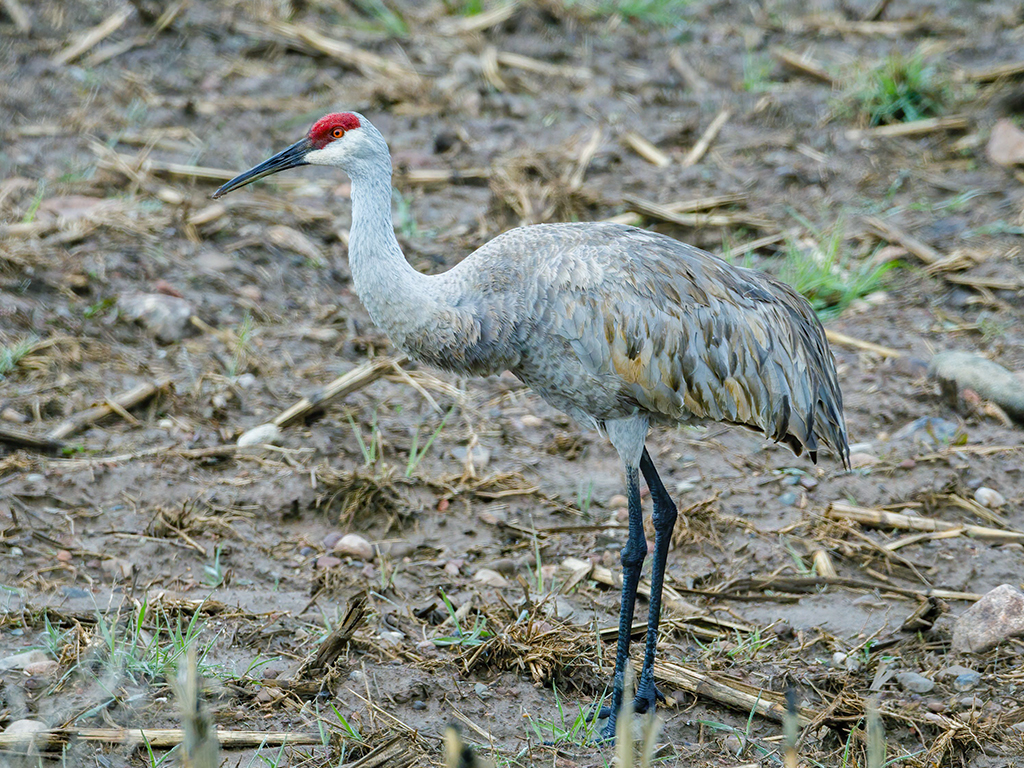
The Sandhill Crane is a large bird, standing up to 1.2 meters tall, with a wingspan of nearly 2 meters. It is recognized by its gray plumage, long neck, and legs, with a distinctive red patch on its forehead.
During flight, the long neck is kept straight, and the black wingtips are visible. Sandhill Cranes are found in open wetlands, fields, and prairies across North America. They are omnivorous, feeding on plants, grains, insects, small mammals, and amphibians.
Known for their elaborate dancing displays, these birds have a loud, trumpeting call. They migrate in large flocks to their breeding grounds in northern regions.
| Kingdom | Animalia |
| Phylum | Chordata |
| Clade | Dinosauria |
| Class | Aves |
| Order | Gruiformes |
| Family | Gruidae |
| Genus | Antigone |
| Species | A. canadensis |
3. Dark-Eyed Junco (Junco hyemalis)

The Dark-Eyed Junco is a small, sparrow-sized bird, about 13-17 cm long. It is known for its slate-gray plumage, with a white belly and a distinctive pink beak. There are several regional variations in color, including the “Slate-colored” and “Oregon” types.
These birds are common across North America, and often found in forests, gardens, and suburban areas. They primarily feed on seeds and insects.
Dark-eyed juncos are ground feeders and can be seen hopping on the ground, often in flocks. Their song is a trill similar to the chipping of a sparrow, and they have a distinctive high-pitched call.
| Kingdom | Animalia |
| Phylum | Chordata |
| Clade | Dinosauria |
| Class | Aves |
| Order | Passeriformes |
| Family | Passerellidae |
| Genus | Junco |
| Species | J. hyemalis |
4. California Scrub Jay (Aphelocoma californica)

The California Scrub Jay is a medium-sized bird, approximately 27-31 cm in length, known for its striking blue and gray plumage. It has a blue head, wings, and tail, with a grayish-brown back and a whitish throat with a blue necklace.
These jays are native to western North America, and primarily found in scrub, oak woodlands, and suburban areas. They are highly intelligent and are known for their bold behavior.
Their diet includes insects, fruits, seeds, and sometimes small animals. They are also known for their acorn storage behavior. The California Scrub Jay has a variety of calls, including harsh and raspy sounds.
| Kingdom | Animalia |
| Phylum | Chordata |
| Clade | Dinosauria |
| Class | Aves |
| Order | Passeriformes |
| Family | Corvidae |
| Genus | Aphelocoma |
| Species | A. californica |
5. American Robin (Turdus migratorius)

| Kingdom | Animalia |
| Phylum | Chordata |
| Clade | Dinosauria |
| Class | Aves |
| Order | Passeriformes |
| Family | Turdidae |
| Genus | Turdus |
| Species | T. migratorius |
6. White-Breasted Nuthatch (Sitta carolinensis)

The White-Breasted Nuthatch is a small bird, about 13-14 cm in length, easily recognized by its large head, short tail, and strong bill. It has a distinctive white face and underparts, with a blue-gray upper body and a black cap.
Found across North America in woods and forests, this bird is known for its unique ability to walk headfirst down tree trunks. It feeds mainly on insects, seeds, and nuts, often caching food for later.
The White-Breasted Nuthatch has a loud, nasal call and a rapid “yank-yank” sound. These birds are solitary or found in pairs and are known for their agility and acrobatic skills.
| Kingdom | Animalia |
| Phylum | Chordata |
| Clade | Dinosauria |
| Class | Aves |
| Order | Passeriformes |
| Family | Sittidae |
| Genus | Sitta |
| Species | S. carolinensis |
7. Mountain Chickadee (Poecile gambeli)

The Mountain Chickadee is a small, charismatic bird approximately 13-15 cm long. It has a distinctive white stripe above the eye and a black cap and throat, with a gray back, wings, and tail.
This bird is native to the mountainous regions of western North America. It inhabits forests, especially those of pine and mixed conifers.
The diet of the Mountain Chickadee primarily consists of insects, seeds, and berries. Known for its curiosity and boldness, this bird has a distinctive call that sounds like its name, “chick-a-dee-dee-dee.” In winter, they often join mixed-species foraging flocks.
| Kingdom | Animalia |
| Phylum | Chordata |
| Clade | Dinosauria |
| Class | Aves |
| Order | Passeriformes |
| Family | Paridae |
| Genus | Poecile |
| Species | P. gambeli |
8. Golden-Crowned Kinglet (Regulus satrapa)

The Golden-Crowned Kinglet is a tiny bird, measuring about 8-11 cm in length, with a distinctive yellow and black stripe on its head. It has olive-green plumage with a whitish underbelly and wing bars.
These birds are found in coniferous forests across North America and into Central America. They feed on small insects and spiders, often foraging high in the treetops.
Despite their small size, Golden-Crowned Kinglets are hardy and can withstand very cold temperatures. Their song is a series of high-pitched notes, and they have a thin, high call. They are active and restless birds, constantly moving through the foliage.
| Kingdom | Animalia |
| Phylum | Chordata |
| Clade | Dinosauria |
| Class | Aves |
| Order | Passeriformes |
| Family | Regulidae |
| Genus | Regulus |
| Species | R. satrapa |
9. Red-Breasted Nuthatch (Sitta canadensis)

The Red-Breasted Nuthatch is a small bird, about 11-12 cm long, known for its bluish-gray upperparts and rusty-brown underparts. It has a black cap and eye-line with a white face and throat.
This species is found in coniferous forests across North America. Like other nuthatches, it is known for its ability to climb down trees headfirst and its habit of wedging nuts into tree bark to break them open.
The Red-Breasted Nuthatch feeds on insects and seeds and is known for its nasal calls. It often joins mixed-species flocks in winter. Their presence is often indicated by their distinctive, repetitive “yank-yank” call.
| Kingdom | Animalia |
| Phylum | Chordata |
| Clade | Dinosauria |
| Class | Aves |
| Order | Passeriformes |
| Family | Sittidae |
| Genus | Sitta |
| Species | S. canadensis |
10. Townsend’s Solitaire (Myadestes townsendi)

Townsend’s Solitaire is a medium-sized bird, about 20-23 cm in length, with a long tail and short bill. It has a gray body, white eye-ring, and distinctive buffy wing patches.
This bird is native to the mountainous regions of western North America. It prefers open coniferous and mixed forests for habitat. The diet of Townsend’s Solitaire is varied, including insects and small fruits, with a particular fondness for juniper berries.
This species is known for its melodious and flute-like song, often heard during early morning and evening. Townsend’s Solitaires are solitary birds, and they defend their feeding territories aggressively, especially in winter.
| Kingdom | Animalia |
| Phylum | Chordata |
| Clade | Dinosauria |
| Class | Aves |
| Order | Passeriformes |
| Family | Turdidae |
| Genus | Myadestes |
| Species | M. townsendi |
11. Ruby-Crowned Kinglet (Regulus calendula)
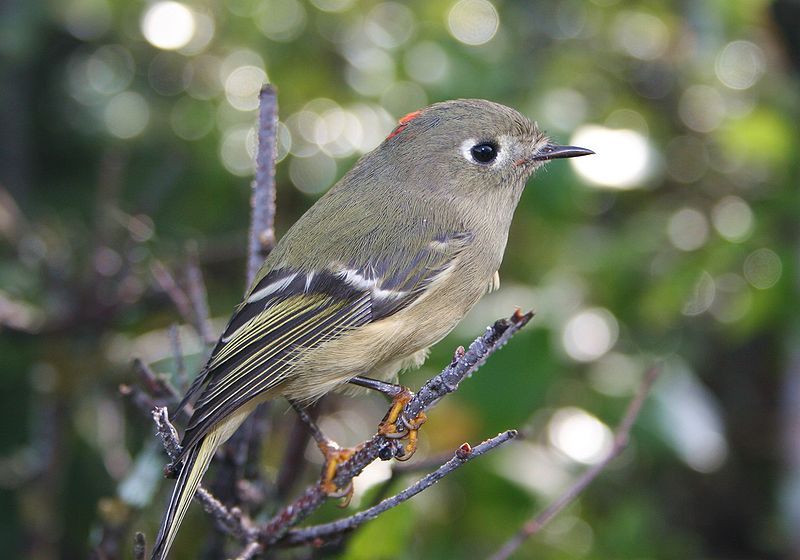
The Ruby-Crowned Kinglet is a tiny, energetic bird, measuring about 9-11 cm in length. It has olive-green plumage with a prominent white eye-ring and wing bars. The male has a concealed ruby-red crown patch, which is often not visible.
Found across North America, particularly in forests, these birds are voracious insect eaters but also consume berries and seeds.
They are known for their constant motion and high-pitched, jumbled song. The Ruby-Crowned Kinglet builds a well-hidden, cup-shaped nest and is often seen flitting about in trees and shrubs, foraging for insects.
| Kingdom | Animalia |
| Phylum | Chordata |
| Clade | Dinosauria |
| Class | Aves |
| Order | Passeriformes |
| Family | Regulidae |
| Genus | Corthylio |
| Species | C. calendula |
12. American Kestrel (Falco sparverius)

The American Kestrel is the smallest falcon in North America, about 22-31 cm in length. It has a colorful plumage, with a rusty back and tail, blue-gray wings, and a white underbelly with black spots.
Males have a blue-gray head with a rust-colored crown, while females have a streaked brown head. These birds are found in a variety of open habitats, including fields, meadows, and deserts.
They feed on insects, small mammals, and birds, often seen hovering in the air before diving to catch prey. American Kestrels are known for their keen eyesight and agile flying skills.
| Kingdom | Animalia |
| Phylum | Chordata |
| Clade | Dinosauria |
| Class | Aves |
| Order | Falconiformes |
| Family | Falconidae |
| Genus | Falco |
| Species | F. sparverius |
13. Steller’s Jay (Cyanocitta stelleri)

Steller’s Jay is a large, striking bird, about 30-34 cm long. It has a bold black head and crest, with a blue body, wings, and tail. This jay is native to western North America, typically found in coniferous and mixed forests.
It is known for its loud, harsh calls and its intelligence. Steller’s Jays are omnivorous, eating nuts, seeds, insects, and occasionally small animals.
They are also known for their mimicry skills, imitating the calls of other birds and animals. These birds are often seen in pairs or small groups and are known to be quite bold around humans.
| Kingdom | Animalia |
| Phylum | Chordata |
| Clade | Dinosauria |
| Class | Aves |
| Order | Passeriformes |
| Family | Corvidae |
| Genus | Cyanocitta |
| Species | C. stelleri |
14. Red-Naped Sapsucker (Sphyrapicus nuchalis)

The Red-Naped Sapsucker is a medium-sized woodpecker, about 19-21 cm long. It has black and white plumage with a red throat, nape, and crown. This bird is found in forests of western North America.
It is known for drilling rows of sap wells in trees and feeding on the sap and insects attracted to it. The Red-Naped Sapsucker plays an important ecological role, as its sap wells provide food for other species too.
They have a distinct drumming pattern and a variety of calls including mewing and whining sounds.
| Kingdom | Animalia |
| Phylum | Chordata |
| Clade | Dinosauria |
| Class | Aves |
| Order | Piciformes |
| Family | Picidae |
| Genus | Sphyrapicus |
| Species | S. nuchalis |
15. Brown Creeper (Certhia americana)

The Brown Creeper is a small, inconspicuous bird, about 11-14 cm in length. It has mottled brown plumage that camouflages well against tree bark.
This bird is found in wooded areas across North America, often seen spiraling upwards around tree trunks searching for insects in the bark.
It has a slender, down-curved bill and stiff tail feathers that help it cling to the bark. Brown Creepers are known for their high-pitched, thin song and a short “tseep” call.
They build their nests behind peeling pieces of bark on dead or dying trees.
| Kingdom | Animalia |
| Phylum | Chordata |
| Clade | Dinosauria |
| Class | Aves |
| Order | Passeriformes |
| Family | Certhiidae |
| Genus | Certhia |
| Species | C. americana |
16. House Sparrow (Passer domesticus)

| Kingdom | Animalia |
| Phylum | Chordata |
| Clade | Dinosauria |
| Class | Aves |
| Order | Passeriformes |
| Family | Passeridae |
| Genus | Passer |
| Species | P. domesticus |
17. House Finch (Haemorhous mexicanus)

The House Finch is a small, colorful bird, about 12-14 cm in length. Males have a red head and breast, with streaky brown backs, tails, and wings. Females are brown and streaked overall, lacking the red coloration.
This species is native to western North America but has been introduced to the eastern part of the continent. House Finches are commonly found in urban and suburban areas, often visiting bird feeders. They primarily eat seeds, fruits, and occasionally insects.
Known for their cheerful, warbling song, House Finches are social birds and often form large flocks, particularly in winter. They are adaptable and thrive in human-altered environments.
| Kingdom | Animalia |
| Phylum | Chordata |
| Clade | Dinosauria |
| Class | Aves |
| Order | Passeriformes |
| Family | Fringillidae |
| Genus | Haemorhous |
| Species | H. mexicanus |
18. Black-Chinned Hummingbird (Archilochus alexandri)

The Black-Chinned Hummingbird is a small and agile bird, measuring about 8-9 cm in length. It has a slender body and a long, straight bill. The male has a black throat with a purple iridescent lower border, while the female has a white throat and underparts.
They have metallic green upperparts and a white collar. These hummingbirds are found in a variety of habitats in the western United States and Mexico, including gardens, woodlands, and deserts.
They primarily feed on nectar from flowers and small insects. The Black-Chinned Hummingbird is known for its rapid wing beats and hovering ability. Their call is a soft, repeated “chip,” and males perform a distinctive dive display during courtship.
| Kingdom | Animalia |
| Phylum | Chordata |
| Clade | Strisores |
| Class | Aves |
| Order | Apodiformes |
| Family | Trochilidae |
| Genus | Archilochus |
| Species | A. alexandri |
19. Mourning Dove (Zenaida macroura)

The Mourning Dove is a medium-sized bird, about 23-34 cm long, with a slender, tailed profile. It has soft gray-brown plumage, with black spots on the wings and a distinctive black mark on the face.
The underparts are lighter, and the tail has white edges. Common across North America, they inhabit open areas, farmlands, and urban settings.
Mourning Doves feed on seeds, grains, and occasionally insects. They are known for their soft, mournful cooing, which gives them their name. These birds are strong fliers and can reach high speeds during flight.
| Kingdom | Animalia |
| Phylum | Chordata |
| Clade | Dinosauria |
| Class | Aves |
| Order | Columbiformes |
| Family | Columbidae |
| Genus | Zenaida |
| Species | Z. macroura |
20. White-Winged Dove (Zenaida asiatica)

The White-Winged Dove is a large, stocky dove, about 28-31 cm in length. It has a grayish-brown body, with distinctive white edges on its wings visible in flight. The tail is squared with a black band and white tips.
The face has a bluish eye-ring and a small, black mark on the cheek. Native to the southwestern United States, Mexico, and Central America, they inhabit desert, urban, and suburban areas.
They feed on seeds, fruits, and occasionally nectar. The White-Winged Dove has a distinctive, hooting call, often described as “who-cooks-for-you.”
| Kingdom | Animalia |
| Phylum | Chordata |
| Clade | Dinosauria |
| Class | Aves |
| Order | Columbiformes |
| Family | Columbidae |
| Genus | Zenaida |
| Species | Z. asiatica |
21. White-Crowned Sparrow (Zonotrichia leucophrys)
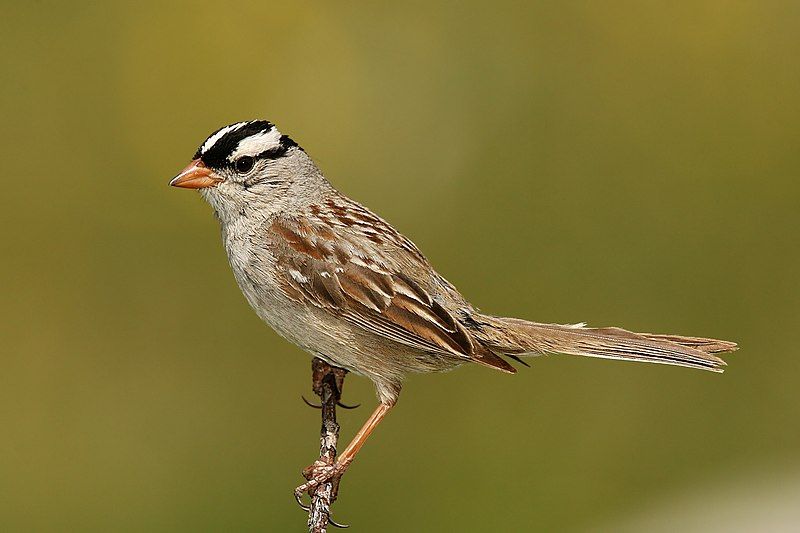
The White-Crowned Sparrow is a medium-sized sparrow, approximately 17 cm long. It is easily identified by its bold black and white stripes on the head. The bird has a gray face, throat, and underparts, with brown-streaked upperparts.
These sparrows are found in a variety of habitats, including brushlands, woodlands, and urban gardens across North America. They feed on seeds, fruits, and insects.
White-Crowned Sparrows are known for their clear, whistling song, which varies regionally. They are often seen foraging on the ground in flocks, especially during migration.
| Kingdom | Animalia |
| Phylum | Chordata |
| Clade | Dinosauria |
| Class | Aves |
| Order | Passeriformes |
| Family | Passerellidae |
| Genus | Zonotrichia |
| Species | Z. leucophrys |
22. Lesser Goldfinch (Spinus psaltria)
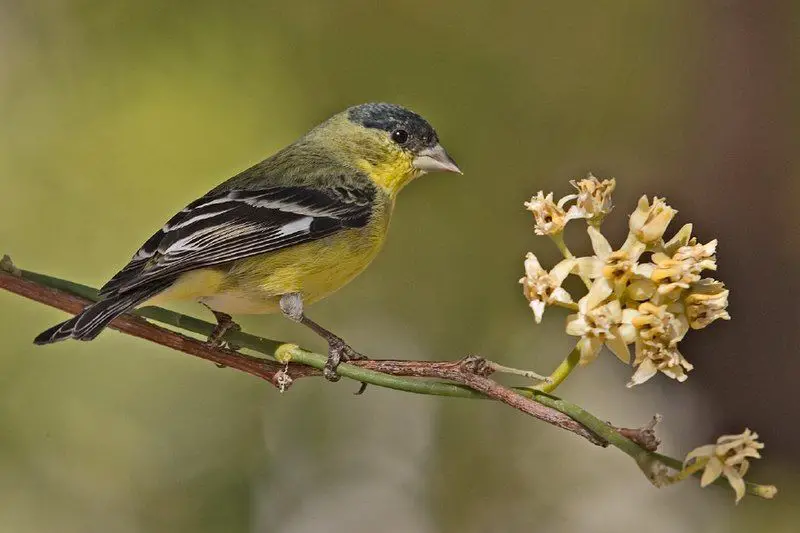
The Lesser Goldfinch is a small finch, measuring about 9-11 cm in length. The male has bright yellow underparts and rump, with a black cap, wings, and tail. The female is more subdued, with olive-gray upperparts and yellowish underparts.
These birds are found in open woodlands, fields, gardens, and scrub areas in the western and southwestern United States down to South America. Their diet consists mainly of seeds and occasionally insects.
The Lesser Goldfinch is known for its high-pitched, twittering song and calls. They are social birds, often seen in flocks, and are frequent visitors to bird feeders.
| Kingdom | Animalia |
| Phylum | Chordata |
| Clade | Dinosauria |
| Class | Aves |
| Order | Passeriformes |
| Family | Fringillidae |
| Genus | Spinus |
| Species | S. psaltria |
23. Bewick’s Wren (Thryomanes bewickii)

Bewick’s Wren is a small, active bird, measuring about 12-14 cm in length. It has a long, slender body with a long tail that it often holds upright.
The plumage is predominantly brown, with a paler belly and a distinctive white eyebrow stripe. This wren is known for its loud, complex song and is found in a variety of habitats, including brushy areas, woodlands, and suburban gardens across the western United States.
They feed on insects and spiders, often seen hopping and flitting through underbrush. Bewick’s Wrens are curious and bold, frequently investigating human-made structures for potential nesting sites.
| Kingdom | Animalia |
| Phylum | Chordata |
| Clade | Dinosauria |
| Class | Aves |
| Order | Passeriformes |
| Family | Troglodytidae |
| Genus | Thryomanes |
| Species | T. bewickii |
24. Brown-Headed Cowbird (Molothrus ater)

The Brown-Headed Cowbird is a medium-sized blackbird, about 18-22 cm in length. Males have a glossy black body with a distinctive brown head, while females are duller, with a grayish-brown plumage.
Known as a brood parasite, this bird does not build its own nest but lays eggs in the nests of other bird species. They are found in open or semi-open habitats across North America, often near cattle or horses, feeding on insects and seeds.
Brown-Headed Cowbirds are social birds, often seen in flocks, especially during non-breeding seasons.
| Kingdom | Animalia |
| Phylum | Chordata |
| Clade | Dinosauria |
| Class | Aves |
| Order | Passeriformes |
| Family | Icteridae |
| Genus | Molothrus |
| Species | M. ater |
25. Rufous Hummingbird (Selasphorus rufus)

The Rufous Hummingbird is a small and vibrant bird, measuring about 8-9 cm in length. Males have a striking orange-red plumage with a white breast and an iridescent red throat. Females are more subdued, with green upperparts and a speckled throat.
This species is known for its incredible migration, traveling great distances between its breeding grounds in the Pacific Northwest and wintering areas in Mexico.
+They inhabit a variety of habitats, including open woodlands and gardens, feeding predominantly on nectar but also on small insects and spiders. The Rufous Hummingbird is territorial and aggressive, often seen chasing away other hummingbirds from feeding areas.
| Kingdom | Animalia |
| Phylum | Chordata |
| Clade | Strisores |
| Class | Aves |
| Order | Apodiformes |
| Family | Trochilidae |
| Genus | Selasphorus |
| Species | S. rufus |
26. Acorn Woodpecker (Melanerpes formicivorus)
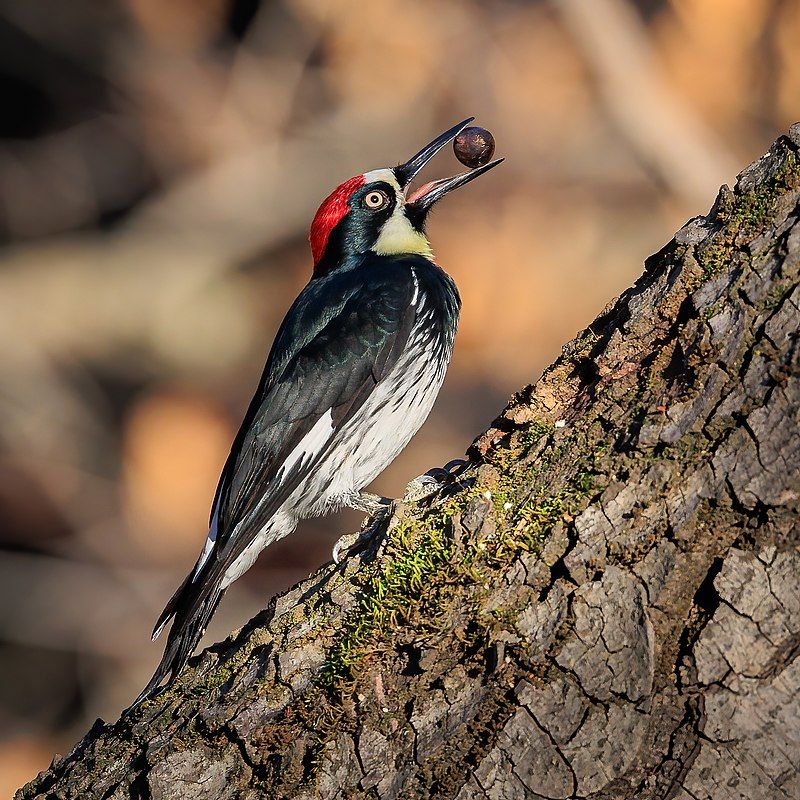
The Acorn Woodpecker is a medium-sized woodpecker, about 19-21 cm long. It has a distinctive black, white, and red face pattern, with a black body and white rump. Both sexes have a red crown, but males also have a red throat patch.
This species is known for its habit of storing acorns in large communal granaries, usually in trees or wooden structures. They are found in oak woodlands across western North America and down into Central America.
Acorn Woodpeckers live in large social groups and have a complex social structure. Their diet consists of acorns, insects, fruit, and occasionally tree sap.
| Kingdom | Animalia |
| Phylum | Chordata |
| Clade | Dinosauria |
| Class | Aves |
| Order | Piciformes |
| Family | Picidae |
| Genus | Melanerpes |
| Species | M. formicivorus |
27. Northern Flicker (Colaptes auratus)

The Northern Flicker is a large woodpecker, about 28-36 cm in length. It has a brownish body with black bars, a black bib, and a distinctive white rump patch visible in flight.
There are two color variants: the “Yellow-shafted” in the east and north, with yellow underwing feathers, and the “Red-shafted” in the west, with red underwing feathers. Northern Flickers prefer open habitats like woods, edges, and clearings.
Unlike other woodpeckers, they often feed on the ground, mainly eating ants and beetles. They have a loud, ringing call and a distinctive drumming pattern. These birds are known for their beautiful, undulating flight.
| Kingdom | Animalia |
| Phylum | Chordata |
| Clade | Dinosauria |
| Class | Aves |
| Order | Piciformes |
| Family | Picidae |
| Genus | Colaptes |
| Species | C. auratus |
28. Gray-Crowned Rosy Finch (Leucosticte tephrocotis)

The Gray-Crowned Rosy Finch is a medium-sized finch, measuring about 14-16 cm in length. It is characterized by its gray crown and nape, dark brown back, and rosy pink underparts and wings.
Found primarily in alpine and Arctic regions of North America, this bird is well adapted to cold environments. It breeds in rocky, mountainous areas and descends to lower elevations in winter.
The Gray-Crowned Rosy Finch feeds mainly on seeds, but during breeding season, it also eats insects.
These birds are social and often found in flocks. They have a simple, twittering song and are known for their hardy nature, thriving in harsh, snowy landscapes.
| Kingdom | Animalia |
| Phylum | Chordata |
| Clade | Dinosauria |
| Class | Aves |
| Order | Passeriformes |
| Family | Fringillidae |
| Genus | Leucosticte |
| Species | L. tephrocotis |
29. Purple Finch (Haemorhous purpureus)

The Purple Finch is a small bird, about 12-15 cm long, with a stocky build and a short, notched tail. The male has a raspberry red head, breast, and back, while the female is brown with bold, white underparts and a streaked back.
These finches inhabit coniferous and mixed forests, as well as suburban areas in eastern North America and along the Pacific coast.
Their diet consists primarily of seeds and fruits, supplemented by insects during the breeding season. The Purple Finch has a rich, melodious song and a warbling call. They are often seen at bird feeders and are known for their cheerful presence.
| Kingdom | Animalia |
| Phylum | Chordata |
| Clade | Dinosauria |
| Class | Aves |
| Order | Passeriformes |
| Family | Fringillidae |
| Genus | Haemorhous |
| Species | H. purpureus |
30. Song Sparrow (Melospiza melodia)

The Song Sparrow is a medium-sized sparrow, measuring about 15-17 cm in length. It has a streaked brown appearance with a distinctive, dark spot on its white breast and a striped head.
This bird is widespread across North America, inhabiting a variety of environments, including marshes, fields, and gardens.
The Song Sparrow is known for its melodious and complex song, which varies geographically. They feed on seeds, fruits, and insects.
These birds are adaptable and often found near human habitation. Their nests are well hidden in dense vegetation, and they are known for their vigorous defense of their territory.
| Kingdom | Animalia |
| Phylum | Chordata |
| Clade | Dinosauria |
| Class | Aves |
| Order | Passeriformes |
| Family | Passerellidae |
| Genus | Melospiza |
| Species | M. melodia |
31. Great Horned Owl (Bubo virginianus)
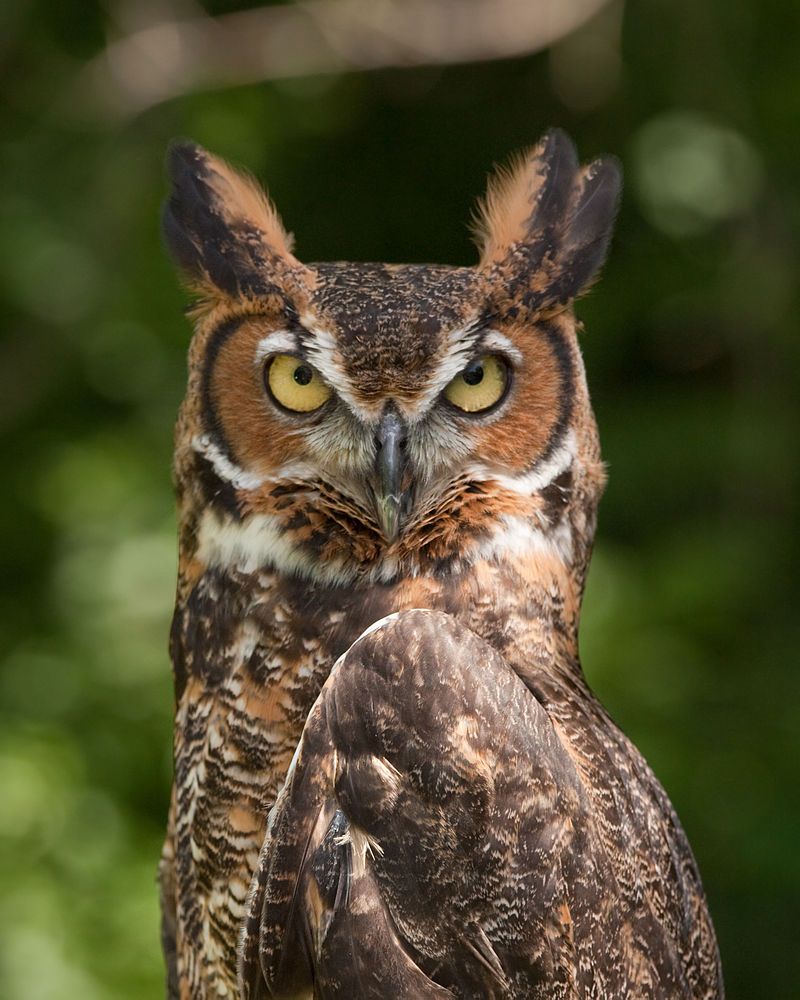
The Great Horned Owl is a large, powerful bird of prey, measuring about 46-63 cm in length. It has a distinctive appearance with tufted ears, large yellow eyes, and a mottled brown-gray plumage.
This owl is found in a wide range of habitats across North and South America, including forests, deserts, and urban areas.
It preys on a variety of animals, including rodents, birds, and reptiles. The Great Horned Owl is known for its deep, resonating hoots and is a symbol of strength in many cultures.
They are mostly nocturnal and are excellent hunters, using their keen vision and hearing to locate prey.
| Kingdom | Animalia |
| Phylum | Chordata |
| Clade | Dinosauria |
| Class | Aves |
| Order | Strigiformes |
| Family | Strigidae |
| Genus | Bubo |
| Species | B. virginianus |
32. American Crow (Corvus brachyrhynchos)

The American Crow is a large, intelligent bird, about 40-50 cm in length. It has all-black plumage with a metallic sheen and a strong, stout bill.
These crows are extremely adaptable and found in a wide range of habitats across North America, including forests, fields, and urban areas.
They have a varied diet, eating insects, fruits, seeds, and garbage. American Crows are known for their problem-solving skills and complex social structure.
They have a variety of calls, with the most common being a loud caw. These birds often gather in large flocks, especially in winter, and are known for their loud, raucous behavior.
| Kingdom | Animalia |
| Phylum | Chordata |
| Clade | Dinosauria |
| Class | Aves |
| Order | Passeriformes |
| Family | Corvidae |
| Genus | Corvus |
| Species | C. brachyrhynchos |
33. Broad-Tailed Hummingbird (Selasphorus platycercus)

The Broad-Tailed Hummingbird is a small bird, measuring about 9-10 cm in length, known for its iridescent green upperparts and white underparts.
Males have a rose-red throat and a rounded tail, while females have a striped throat and a notched tail. This species is found in mountainous regions in the western United States and Central America.
They prefer open woodlands and meadows, feeding on nectar from flowers and catching insects in mid-air. The male’s wings produce a distinctive trilling sound during flight.
The Broad-Tailed Hummingbird is known for its ability to enter torpor, a hibernation-like state, to survive cold nights.
| Kingdom | Animalia |
| Phylum | Chordata |
| Clade | Strisores |
| Class | Aves |
| Order | Apodiformes |
| Family | Trochilidae |
| Genus | Selasphorus |
| Species | S. platycercus |
34. Red-Winged Blackbird (Agelaius phoeniceus)

The Red-Winged Blackbird is a medium-sized bird, about 17-23 cm in length. Males are black with bright red and yellow shoulder patches, while females are brown and heavily streaked.
This species inhabits wetlands, marshes, and agricultural areas across North America. They are highly social and often found in large flocks, especially outside of the breeding season.
The Red-Winged Blackbird’s diet consists mainly of seeds and insects. Known for its loud, conk-la-ree! song, this bird is a familiar sight perched on cattails or telephone wires.
| Kingdom | Animalia |
| Phylum | Chordata |
| Clade | Dinosauria |
| Class | Aves |
| Order | Passeriformes |
| Family | Icteridae |
| Genus | Agelaius |
| Species | A. phoeniceus |
35. Yellow-Rumped Warbler (Setophaga coronata)

The Yellow-Rumped Warbler is a small bird, about 12-15 cm in length, with a striking appearance. It has a blue-gray back, a white throat, and a black mask.
The most distinctive feature is the bright yellow rump, which is visible in flight. There are two main varieties, the “Myrtle” in the east and the “Audubon’s” in the west.
They inhabit a variety of habitats, including forests, coastal areas, and urban parks across North America. Their diet includes insects and berries.
The Yellow-Rumped Warbler is known for its ability to digest the waxes in bayberries and wax myrtle, allowing it to winter farther north than other warblers.
| Kingdom | Animalia |
| Phylum | Chordata |
| Clade | Dinosauria |
| Class | Aves |
| Order | Passeriformes |
| Family | Parulidae |
| Genus | Setophaga |
| Species | S. coronata |
36. Common Starling (Sturnus vulgaris)

The Common Starling is a medium-sized bird, about 19-22 cm in length, with a short tail and pointed wings. It has glossy black plumage with iridescent purple and green, and in winter, it is speckled with white.
Native to Eurasia, this bird has been introduced to other regions, including North America. Common Starlings are highly adaptable and often found in urban areas, fields, and near livestock.
They feed on a variety of foods, including insects, fruits, and human food scraps. Starlings are known for their mimicry skills and can imitate a wide range of sounds, from other bird calls to mechanical noises.
| Kingdom | Animalia |
| Phylum | Chordata |
| Clade | Dinosauria |
| Class | Aves |
| Order | Passeriformes |
| Family | Sturnidae |
| Genus | Sturnus |
| Species | S. vulgaris |
37. Northern Mockingbird (Mimus polyglottos)

| Kingdom | Animalia |
| Phylum | Chordata |
| Clade | Dinosauria |
| Class | Aves |
| Order | Passeriformes |
| Family | Mimidae |
| Genus | Mimus |
| Species | M. polyglottos |
38. Black-Capped Chickadee (Poecile atricapillus)

The Black-Capped Chickadee is a small, charismatic bird, about 12-15 cm in length. It has a distinctive black cap and bib, with white cheeks, gray back, and fluffy, light underparts.
This bird is known for its curiosity and friendliness towards humans. Found in forests, woodlands, and suburban areas across the northern United States and Canada, it feeds on insects, seeds, and berries.
The Black-Capped Chickadee is renowned for its distinctive “chick-a-dee-dee-dee” call, from which it gets its name. They are also known for their remarkable memory, able to remember thousands of locations where they store food.
| Kingdom | Animalia |
| Phylum | Chordata |
| Clade | Dinosauria |
| Class | Aves |
| Order | Passeriformes |
| Family | Paridae |
| Genus | Poecile |
| Species | P. atricapillus |
39. American Bushtit (Psaltriparus minimus)

The American Bushtit is a tiny, social bird, measuring just about 7-11 cm long. It has a soft, gray-brown plumage, with a long tail and a short bill.
Males and females look similar, but some populations have males with dark eyes and females with yellow eyes.
These birds are found in woodlands, chaparral, and gardens in the western United States and Mexico.
They feed on insects and spiders, often seen in active, chattering flocks. American Bushtits are known for their elaborate, hanging nests, woven like a sock and large enough to house their communal roosts.
| Kingdom | Animalia |
| Phylum | Chordata |
| Clade | Dinosauria |
| Class | Aves |
| Order | Passeriformes |
| Family | Aegithalidae |
| Genus | Psaltriparus |
| Species | P. minimus |
40. Cassin’s Finch (Haemorhous cassinii)

Cassin’s Finch is a medium-sized finch, about 15-16 cm in length. The male has a rosy-pink head and chest with brown streaked back and wings, while the female is brown and streaked overall.
This bird inhabits coniferous forests and mixed woodlands in the mountains of western North America. Their diet consists of seeds, buds, and berries, supplemented by insects during the breeding season.
Cassin’s Finch is known for its melodious song, which resembles a warbled version of the House Finch’s song. They are often seen at higher elevations, foraging in trees or on the ground.
| Kingdom | Animalia |
| Phylum | Chordata |
| Clade | Dinosauria |
| Class | Aves |
| Order | Passeriformes |
| Family | Fringillidae |
| Genus | Haemorhous |
| Species | H. cassinii |
41. Cooper’s Hawk (Accipiter cooperii)
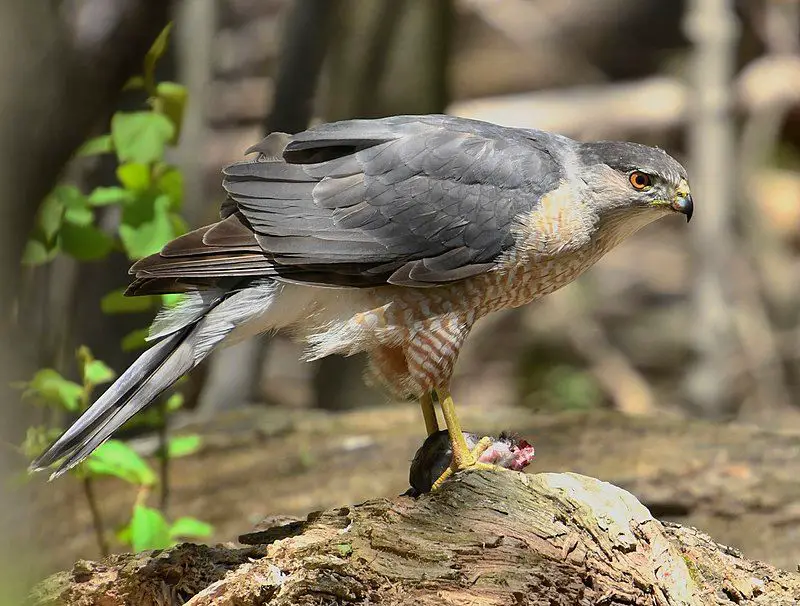
Cooper’s Hawk is a medium-sized hawk, about 35-50 cm in length, with a long, banded tail and short, rounded wings. They have a blue-gray back with a reddish-orange barred chest and belly.
These hawks are adept flyers, maneuvering skillfully through dense trees. Found in forests and urban areas across North America, they prey primarily on birds and small mammals.
Cooper’s Hawks are known for their fast, agile hunting and are often seen darting after prey through trees and over fields. They have a sharp, piercing call and are becoming increasingly common in urban settings.
| Kingdom | Animalia |
| Phylum | Chordata |
| Clade | Dinosauria |
| Class | Aves |
| Order | Accipitriformes |
| Family | Accipitridae |
| Genus | Accipiter |
| Species | A. cooperii |
42. Northern Harrier (Circus hudsonius)

The Northern Harrier is a medium-sized raptor, about 41-52 cm in length, with a distinctive long, slender body and wings. It has a flat, owl-like face which helps it to hear rodents while flying low over open fields.
Males are gray with black wingtips, while females are brown with streaks and have a distinctive white rump patch. This bird is found in open habitats such as marshes, grasslands, and fields across North America and Eurasia.
The Northern Harrier feeds primarily on small mammals and birds, using its exceptional hearing and sight for hunting. It is known for its unique hunting method, flying low and slowly over the ground. Its call is a harsh, chattering chirp.
| Kingdom | Animalia |
| Phylum | Chordata |
| Clade | Dinosauria |
| Class | Aves |
| Order | Accipitriformes |
| Family | Accipitridae |
| Genus | Circus |
| Species | C. hudsonius |
43. Eurasian Goshawk (Accipiter gentilis)
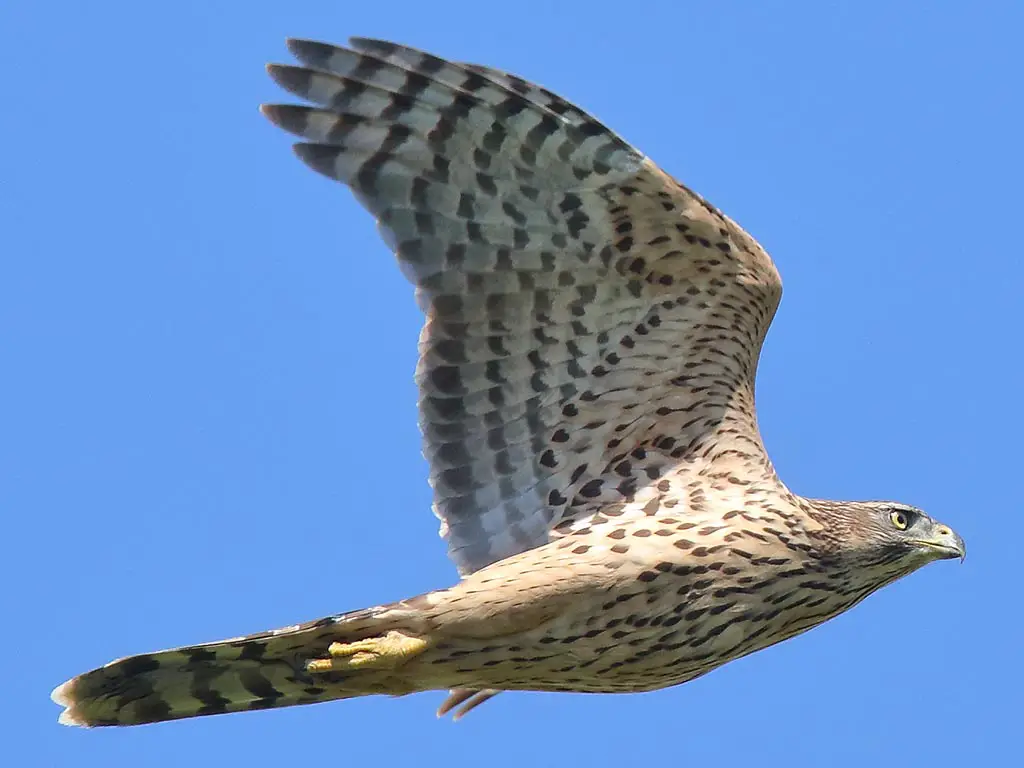
The Eurasian Goshawk is a large hawk, measuring about 46-61 cm in length. It has a robust body, broad wings, and a long tail. The adult has a slate-gray back and a pale underpart with fine dark streaking.
Juveniles are brown with vertical streaks. This bird is found in wooded areas across Europe, Asia, and parts of North America. It preys on a variety of birds and mammals, capturing them with sudden bursts of speed in a powerful flight.
The Eurasian Goshawk is known for its secretive nature and is rarely seen in the open. It has a sharp, piercing call and is highly territorial, especially during breeding season.
| Kingdom | Animalia |
| Phylum | Chordata |
| Clade | Dinosauria |
| Class | Aves |
| Order | Accipitriformes |
| Family | Accipitridae |
| Genus | Accipiter |
| Species | A. gentilis |
44. Red-Tailed Hawk (Buteo jamaicensis)

The Red-Tailed Hawk is a large bird of prey, about 45-65 cm in length, known for its distinctive red tail. It has a broad, rounded wingspan and a stocky build.
The plumage is usually brown above and pale below, with a streaked belly and a dark bar between the shoulder and wrist.
These hawks are widespread in North America and found in diverse habitats including deserts, grasslands, roadsides, and urban areas.
They feed mainly on small mammals, birds, and reptiles, often seen soaring or perched high on trees or poles. The Red-Tailed Hawk has a distinctive, piercing scream, often used in movies as a generic raptor call.
| Kingdom | Animalia |
| Phylum | Chordata |
| Clade | Dinosauria |
| Class | Aves |
| Order | Accipitriformes |
| Family | Accipitridae |
| Genus | Buteo |
| Species | B. jamaicensis |
45. Sharp-Shinned Hawk (Accipiter striatus)

The Sharp-Shinned Hawk is the smallest in North America, measuring about 23-37 cm in length. It has short, rounded wings and a long tail, which it uses for agile flight in dense forests.
The adult has blue-gray upperparts and thin, horizontal red bars on the underparts. Juveniles are brown with vertical streaks.
These hawks are found in forests across North America, preying primarily on small birds, which they capture in mid-air.
The Sharp-Shinned Hawk is known for its stealth and speed, often surprising its prey. Its call is a high-pitched, kek-kek-kek sound. They are often seen darting through trees during the hunt.
| Kingdom | Animalia |
| Phylum | Chordata |
| Clade | Dinosauria |
| Class | Aves |
| Order | Accipitriformes |
| Family | Accipitridae |
| Genus | Accipiter |
| Species | A. striatus |
Conclusion
Winter birds in New Mexico bring a sense of beauty and wonder during the colder months. These birds, such as the White-crowned Sparrow, Mountain Bluebird, and Juniper Titmouse, are resilient and adapted to survive in the harsh conditions of New Mexico’s winter.
Birdwatchers and enthusiasts can enjoy observing their unique behaviors and vibrant colors, while also contributing to their conservation efforts.
The presence of winter birds not only enhances the biodiversity of New Mexico but also provides an opportunity for people to connect with nature and appreciate the wonders of the avian world.